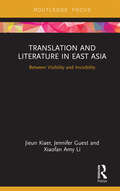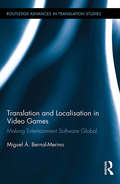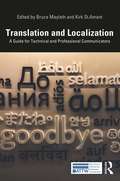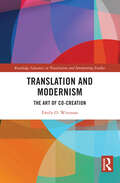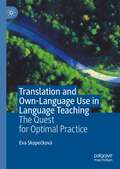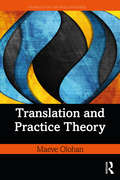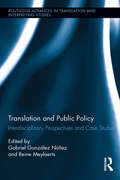- Table View
- List View
Translation and Literature in East Asia: Between Visibility and Invisibility
by Jieun Kiaer Jennifer Guest Xiaofan Amy LiTranslation and Literature in East Asia: Between Visibility and Invisibility explores the issues involved in translation between Chinese, Japanese and Korean, as well as from these languages into European languages, with an eye to comparing the cultures of translation within East Asia and tracking some of their complex interrelationships. This book reasserts the need for a paradigm shift in translation theory that looks beyond European languages and furthers existing work in this field by encompassing a wider range of literature and scholarship in East Asia. Translation and Literature in East Asia brings together material dedicated to the theory and practice of translation between and from East Asian languages for the first time.
Translation and Literature in East Asia: Between Visibility and Invisibility (Routledge Studies In East Asian Translation Ser.)
by Jieun Kiaer Jennifer Guest Xiaofan Amy LiTranslation and Literature in East Asia: Between Visibility and Invisibility explores the issues involved in translation between Chinese, Japanese and Korean, as well as from these languages into European languages, with an eye to comparing the cultures of translation within East Asia and tracking some of their complex interrelationships. This book reasserts the need for a paradigm shift in translation theory that looks beyond European languages and furthers existing work in this field by encompassing a wider range of literature and scholarship in East Asia. Translation and Literature in East Asia brings together material dedicated to the theory and practice of translation between and from East Asian languages for the first time.
Translation and Localisation in Video Games: Making Entertainment Software Global (Routledge Advances in Translation and Interpreting Studies)
by Miguel Á. Bernal-MerinoThis book is a multidisciplinary study of the translation and localisation of video games. It offers a descriptive analysis of the industry – understood as a global phenomenon in entertainment – and aims to explain the norms governing present industry practices, as well as game localisation processes. Additionally, it discusses particular translation issues that are unique to the multichannel nature of video games, in which verbal and nonverbal signs must be cohesively combined with interactivity to achieve maximum playability and immerse players in the game’s virtual world. Although positioned within the theoretical framework of descriptive translation studies, Bernal-Merino incorporates research from audiovisual translation, software localisation, computer assisted translation, comparative literature, and video game production. Moving beyond this framework, Translation and Localisation in Video Games challenges some of the basic tenets of translation studies and proposes changes to established and unsatisfactory processes in the video game and language services industries.
Translation and Localisation in Video Games: Making Entertainment Software Global (Routledge Advances in Translation and Interpreting Studies)
by Miguel Á. Bernal-MerinoThis book is a multidisciplinary study of the translation and localisation of video games. It offers a descriptive analysis of the industry – understood as a global phenomenon in entertainment – and aims to explain the norms governing present industry practices, as well as game localisation processes. Additionally, it discusses particular translation issues that are unique to the multichannel nature of video games, in which verbal and nonverbal signs must be cohesively combined with interactivity to achieve maximum playability and immerse players in the game’s virtual world. Although positioned within the theoretical framework of descriptive translation studies, Bernal-Merino incorporates research from audiovisual translation, software localisation, computer assisted translation, comparative literature, and video game production. Moving beyond this framework, Translation and Localisation in Video Games challenges some of the basic tenets of translation studies and proposes changes to established and unsatisfactory processes in the video game and language services industries.
Translation and Localization: A Guide for Technical and Professional Communicators (ATTW Series in Technical and Professional Communication)
by Bruce Maylath Kirk St. AmantDetailed yet accessible, Translation and Localization brings together the research and insights of veteran practicing translators to offer comprehensive guidance for technical communicators. The volume begins with the fundamentals of translation before leading readers through the process of preparing technical documents for translation. It then presents the broader area of localization, again beginning with its key competencies. Concluding chapters examine the state of the field as computers take on more translation and localization work. Featuring real-life scenarios and a broad range of experienced voices, this is an invaluable resource for technical and professional communicators looking to expand into international markets. This book will be of interest to students of ethnic conflict, Asian politics, and security studies.
Translation and Localization: A Guide for Technical and Professional Communicators (ATTW Series in Technical and Professional Communication)
by Bruce Maylath Kirk St. AmantDetailed yet accessible, Translation and Localization brings together the research and insights of veteran practicing translators to offer comprehensive guidance for technical communicators. The volume begins with the fundamentals of translation before leading readers through the process of preparing technical documents for translation. It then presents the broader area of localization, again beginning with its key competencies. Concluding chapters examine the state of the field as computers take on more translation and localization work. Featuring real-life scenarios and a broad range of experienced voices, this is an invaluable resource for technical and professional communicators looking to expand into international markets. This book will be of interest to students of ethnic conflict, Asian politics, and security studies.
Translation and Migration (New Perspectives in Translation and Interpreting Studies)
by Moira InghilleriTranslation and Migration examines the ways in which the presence or absence of translation in situations of migratory movement has currently and historically shaped social, cultural and economic relations between groups and individuals. Acts of cultural and linguistic translation are discussed through a rich variety of illustrative literary, ethnographic, visual and historical materials, also taking in issues of multiculturalism, assimilation, and hybridity analytically re-framed. This is key reading for students undertaking Translation Studies courses, and will also be of interest to researchers in sociology, cultural studies, anthropology and migration studies.
Translation and Migration (New Perspectives in Translation and Interpreting Studies)
by Moira InghilleriTranslation and Migration examines the ways in which the presence or absence of translation in situations of migratory movement has currently and historically shaped social, cultural and economic relations between groups and individuals. Acts of cultural and linguistic translation are discussed through a rich variety of illustrative literary, ethnographic, visual and historical materials, also taking in issues of multiculturalism, assimilation, and hybridity analytically re-framed. This is key reading for students undertaking Translation Studies courses, and will also be of interest to researchers in sociology, cultural studies, anthropology and migration studies.
Translation and Modernism: The Art of Co-Creation (Routledge Advances in Translation and Interpreting Studies)
by Emily O. WittmanThis innovative volume extends existing conversations on translation and modernism with an eye toward bringing renewed attention to its ethically complex, appropriative nature and the subsequent ways in which modernist translators become co-creators of the materials they translate. Wittman builds on existing work at the intersection of the two fields to offer a more dynamic, nuanced, and wider lens on translation and modernism. The book draws on scholarship from descriptive translation studies, polysystems theory, and literary translation to explore modernist translators’ appropriation of source texts and their continuous recalibrations of equivalence between source text and translation. Chapters focus on translation projects from a range of writers, including Beckett, Garnett, Lawrence, Mansfield, and Rhys, with a particular spotlight on how women’s translations and women translators’ innovations were judged more critically than those of their male counterparts. Taken together, the volume puts forth a fresh perspective on translation and modernism and of the role of the modernist translator as co-creator in the translation process. This book will be of particular interest to scholars in translation studies, modernism, reception theory, and gender studies.
Translation and Modernism: The Art of Co-Creation (Routledge Advances in Translation and Interpreting Studies)
by Emily O. WittmanThis innovative volume extends existing conversations on translation and modernism with an eye toward bringing renewed attention to its ethically complex, appropriative nature and the subsequent ways in which modernist translators become co-creators of the materials they translate. Wittman builds on existing work at the intersection of the two fields to offer a more dynamic, nuanced, and wider lens on translation and modernism. The book draws on scholarship from descriptive translation studies, polysystems theory, and literary translation to explore modernist translators’ appropriation of source texts and their continuous recalibrations of equivalence between source text and translation. Chapters focus on translation projects from a range of writers, including Beckett, Garnett, Lawrence, Mansfield, and Rhys, with a particular spotlight on how women’s translations and women translators’ innovations were judged more critically than those of their male counterparts. Taken together, the volume puts forth a fresh perspective on translation and modernism and of the role of the modernist translator as co-creator in the translation process. This book will be of particular interest to scholars in translation studies, modernism, reception theory, and gender studies.
Translation and Multimodality: Beyond Words
by Ángeles Carreres Marcus Tomalin Monica Boria Maria Noriega-SánchezTranslation and Multimodality: Beyond Words is one of the first books to explore how translation needs to be redefined and reconfigured in contexts where multiple modes of communication, such as writing, images, gesture, and music, occur simultaneously. Bringing together world-leading experts in translation theory and multimodality, each chapter explores important interconnections among these related, yet distinct, disciplines. As communication becomes ever more multimodal, the need to consider translation in multimodal contexts is increasingly vital. The various forms of meaning-making that have become prominent in the twenty-first century are already destabilising certain time-honoured translation-theoretic paradigms, causing old definitions and assumptions to appear inadequate. This ground-breaking volume explores these important issues in relation to multimodal translation with examples from literature, dance, music, TV, film, and the visual arts. Encouraging a greater convergence between these two significant disciplines, this text is essential for advanced students and researchers in Translation Studies, Linguistics, and Communication Studies.
Translation and Multimodality: Beyond Words
by Ángeles Carreres Marcus Tomalin Monica Boria Maria Noriega-SánchezTranslation and Multimodality: Beyond Words is one of the first books to explore how translation needs to be redefined and reconfigured in contexts where multiple modes of communication, such as writing, images, gesture, and music, occur simultaneously. Bringing together world-leading experts in translation theory and multimodality, each chapter explores important interconnections among these related, yet distinct, disciplines. As communication becomes ever more multimodal, the need to consider translation in multimodal contexts is increasingly vital. The various forms of meaning-making that have become prominent in the twenty-first century are already destabilising certain time-honoured translation-theoretic paradigms, causing old definitions and assumptions to appear inadequate. This ground-breaking volume explores these important issues in relation to multimodal translation with examples from literature, dance, music, TV, film, and the visual arts. Encouraging a greater convergence between these two significant disciplines, this text is essential for advanced students and researchers in Translation Studies, Linguistics, and Communication Studies.
Translation and Mysticism: The Rose and the Wherefore (Routledge Studies in Literary Translation)
by Philip WilsonThis book examines how mysticism can tell us about translation and translation can tell us about mysticism, addressing the ancient but ongoing connections between the art of rendering one text in another language and the art of the ineffable.The volume represents the first sustained act of attention to the interdisciplinary crossover of these two fields, taking a Wittgensteinian approach to language, and investigates how mystics and their translators manage to write about what cannot be written about. Three questions are addressed overall: how mysticism can be used to conceptualise translation; the issues that mysticism raises for translation theory and practice; and how mystical texts have been and might be translated. Walter Benjamin’s ‘The Translator’s Task’ is considered in detail as a controversial example of dialogue. Translation examples are given in a range of languages, and six major case studies are provided, including a close reading of Exodus and an analysis of a recent radical translation of Lucretius. This book will be of interest to students and researchers in translation studies, mysticism studies, theology and literary translation, as well as practising translators.
Translation and Mysticism: The Rose and the Wherefore (Routledge Studies in Literary Translation)
by Philip WilsonThis book examines how mysticism can tell us about translation and translation can tell us about mysticism, addressing the ancient but ongoing connections between the art of rendering one text in another language and the art of the ineffable.The volume represents the first sustained act of attention to the interdisciplinary crossover of these two fields, taking a Wittgensteinian approach to language, and investigates how mystics and their translators manage to write about what cannot be written about. Three questions are addressed overall: how mysticism can be used to conceptualise translation; the issues that mysticism raises for translation theory and practice; and how mystical texts have been and might be translated. Walter Benjamin’s ‘The Translator’s Task’ is considered in detail as a controversial example of dialogue. Translation examples are given in a range of languages, and six major case studies are provided, including a close reading of Exodus and an analysis of a recent radical translation of Lucretius. This book will be of interest to students and researchers in translation studies, mysticism studies, theology and literary translation, as well as practising translators.
Translation and Objects: Rewriting Migrancy and Displacement through the Materiality of Art
by Mª Carmen Vidal ClaramonteTranslation and Objectsoffers a new and original perspective in Translation Studies, originating from the conviction that in today’s world translation is pervasive. Building on the ideas of scholars who have expanded the boundaries of the discipline, this book focuses on the analysis of objects that migrants carry with them on their journey of migration.The ideas of displacement and constant movement are key throughout these pages. Migrants live translation literally, because displacement is a leitmotif for them. Translation and Objects analyzes migrant objects—such as shoes, stones, or photographs—as translation sites that function as expressions as well as sources of emotions. These displaced emotional objects, laden with meanings and sentiments, tell many stories, saying a great deal about their owners, who almost never have a voice. This book shows how meaning is displaced through the materiality, texture, smells, sensations, and forms of moving objects.Including examples of translations that have been created from a no-nlinguistic perspective and exploring linguistic issues whilst connecting them to other fields such as anthropology and sociology, Vidal sets out a broad vision of translation. This is critical reading for translation theory courses within Translation Studies, comparative literature, and cultural studies.With the exception of Chapter 3, no part of this book may be reprinted or reproduced or utilised in any form or by any electronic, mechanical, or other means, now known or hereafter invented, including photocopying and recording, or in any information storage or retrieval system, without permission in writing from the publishers.”
Translation and Objects: Rewriting Migrancy and Displacement through the Materiality of Art
by Mª Carmen Vidal ClaramonteTranslation and Objectsoffers a new and original perspective in Translation Studies, originating from the conviction that in today’s world translation is pervasive. Building on the ideas of scholars who have expanded the boundaries of the discipline, this book focuses on the analysis of objects that migrants carry with them on their journey of migration.The ideas of displacement and constant movement are key throughout these pages. Migrants live translation literally, because displacement is a leitmotif for them. Translation and Objects analyzes migrant objects—such as shoes, stones, or photographs—as translation sites that function as expressions as well as sources of emotions. These displaced emotional objects, laden with meanings and sentiments, tell many stories, saying a great deal about their owners, who almost never have a voice. This book shows how meaning is displaced through the materiality, texture, smells, sensations, and forms of moving objects.Including examples of translations that have been created from a no-nlinguistic perspective and exploring linguistic issues whilst connecting them to other fields such as anthropology and sociology, Vidal sets out a broad vision of translation. This is critical reading for translation theory courses within Translation Studies, comparative literature, and cultural studies.With the exception of Chapter 3, no part of this book may be reprinted or reproduced or utilised in any form or by any electronic, mechanical, or other means, now known or hereafter invented, including photocopying and recording, or in any information storage or retrieval system, without permission in writing from the publishers.”
Translation and Own-Language Use in Language Teaching: The Quest for Optimal Practice
by Eva SkopečkováThis book reconsiders the role of translation and own-language use in the EFL (English as a Foreign Language) classroom. It shows prospective teachers how to use the learners’ own language and translation optimally. The author surveys current research about the EFL classroom and presents both a theoretical framework and a didactic model for using translation and learners’ mother tongues. This is done through an action research project, assessing the proposed didactic model for optimal translation practice in English Language teaching (OTP in ELT) through its integration into teacher education. The book will be of interest to students and researchers in the areas of Translation Studies and Applied Linguistics (particularly EFL, ESL, TEFL and TESOL), as well as educators and designers of pre-service training programmes for language teachers.
Translation and Paratexts (Translation Theories Explored)
by Kathryn BatchelorAs the 'thresholds' through which readers and viewers access texts, paratexts have already sparked important scholarship in literary theory, digital studies and media studies. Translation and Paratexts explores the relevance of paratexts for translation studies and provides a framework for further research. Writing in three parts, Kathryn Batchelor first offers a critical overview of recent scholarship, and in the second part introduces three original case studies to demonstrate the importance of paratextual theory. Batchelor interrogates English versions of Nietzsche, Chinese editions of Western translation theory, and examples of subtitled drama in the UK, before concluding with a final part outlining a theory of paratextuality for translation research, addressing questions of terminology and methodology. Translation and Paratexts is essential reading for students and researchers in translation studies, interpreting studies and literary translation.
Translation and Paratexts (Translation Theories Explored)
by Kathryn BatchelorAs the 'thresholds' through which readers and viewers access texts, paratexts have already sparked important scholarship in literary theory, digital studies and media studies. Translation and Paratexts explores the relevance of paratexts for translation studies and provides a framework for further research. Writing in three parts, Kathryn Batchelor first offers a critical overview of recent scholarship, and in the second part introduces three original case studies to demonstrate the importance of paratextual theory. Batchelor interrogates English versions of Nietzsche, Chinese editions of Western translation theory, and examples of subtitled drama in the UK, before concluding with a final part outlining a theory of paratextuality for translation research, addressing questions of terminology and methodology. Translation and Paratexts is essential reading for students and researchers in translation studies, interpreting studies and literary translation.
Translation and Practice Theory (Translation Theories Explored)
by Maeve OlohanTranslation and Practice Theory is a timely and theoretically innovative study linking professional practice and translation theory, showing the usefulness of a practice-theoretical approach in addressing some of the challenges that the professional world of translation is currently facing, including, for example, the increasing deployment of machine translation. Focusing on the key aspects of translation practices, Olohan provides the reader with an in-depth understanding of how those practices are performed, as translators interact with people, technologies and other material resources in the translation workplace. The practice-theoretical perspective helps to describe and explain the socio-material complexities of present-day commercial translation practice but also offers a productive approach for studies of translation and interpreting practices in other settings and periods. This first book-length exploration of translation through the lens of practice theory is key reading for advanced students and researchers of Translation Theory. It will also be of interest in the area of professional communication within Communication Studies and Applied Linguistics.
Translation and Practice Theory (Translation Theories Explored)
by Maeve OlohanTranslation and Practice Theory is a timely and theoretically innovative study linking professional practice and translation theory, showing the usefulness of a practice-theoretical approach in addressing some of the challenges that the professional world of translation is currently facing, including, for example, the increasing deployment of machine translation. Focusing on the key aspects of translation practices, Olohan provides the reader with an in-depth understanding of how those practices are performed, as translators interact with people, technologies and other material resources in the translation workplace. The practice-theoretical perspective helps to describe and explain the socio-material complexities of present-day commercial translation practice but also offers a productive approach for studies of translation and interpreting practices in other settings and periods. This first book-length exploration of translation through the lens of practice theory is key reading for advanced students and researchers of Translation Theory. It will also be of interest in the area of professional communication within Communication Studies and Applied Linguistics.
Translation and Pragmatics: Theories and Applications
by Louisa DesillaTranslation and Pragmatics aims to provide a fundamental grounding of key phenomena, theories, and concepts in the field of pragmatics and of some of their manifestations both within and across languages and cultures. The originality of this textbook largely resides in its pedagogical approach which involves familiarising students with the pragmatic phenomena of deixis, speech acts, implicature, and (im)politeness first and foremost through a systematic exposure to concrete, authentic data from a broad spectrum of texts and media (e.g., ads, memes, films, videogames) while showcasing how these phenomena are relayed in different types of translation. With warm-up exercises, illustrative case studies, mini-research activities as well as further reading, this is an essential textbook for translation and intercultural communication students but can also be a useful resource for anyone interested in the interface between pragmatics, translation and/or intercultural communication, media, and the synergies thereof.
Translation and Pragmatics: Theories and Applications
by Louisa DesillaTranslation and Pragmatics aims to provide a fundamental grounding of key phenomena, theories, and concepts in the field of pragmatics and of some of their manifestations both within and across languages and cultures. The originality of this textbook largely resides in its pedagogical approach which involves familiarising students with the pragmatic phenomena of deixis, speech acts, implicature, and (im)politeness first and foremost through a systematic exposure to concrete, authentic data from a broad spectrum of texts and media (e.g., ads, memes, films, videogames) while showcasing how these phenomena are relayed in different types of translation. With warm-up exercises, illustrative case studies, mini-research activities as well as further reading, this is an essential textbook for translation and intercultural communication students but can also be a useful resource for anyone interested in the interface between pragmatics, translation and/or intercultural communication, media, and the synergies thereof.
Translation and Public Policy: Interdisciplinary Perspectives and Case Studies (Routledge Advances in Translation and Interpreting Studies)
by Gabriel González Núñez Reine MeylaertsThis book brings together an ensemble of leading voices from the fields of economics, language policy, law, political philosophy, and translation studies. They come together to provide theoretical perspectives and practical case studies regarding a shared concern: translation policy. Their timely perspectives and case studies allow for the problematizing and exploration of translation policy, an area that is beginning to come to the attention of scholars. This book offers the first truly interdisciplinary approach to an area of study that is still in its infancy. It thus makes a timely and necessary contribution. As the 21st century marches on, authorities are more and more confronted with the reality of multilingual societies, and the monolingual state polices of yesteryear seem unable to satisfy increasing demands for more just societies. Precisely because of that, language policies of necessity must include choices about the use or non-use of translation at different levels. Thus, translation policy plays a prominent yet often unseen role in multilingual societies. This role is shaped by tensions and compromises that bear on the distribution of resources, choices about language, legal imperatives, and notions of justice. This book aims to inform scholars and policy makers alike regarding these issues.
Translation and Public Policy: Interdisciplinary Perspectives and Case Studies (Routledge Advances in Translation and Interpreting Studies)
by Gabriel González Núñez Reine MeylaertsThis book brings together an ensemble of leading voices from the fields of economics, language policy, law, political philosophy, and translation studies. They come together to provide theoretical perspectives and practical case studies regarding a shared concern: translation policy. Their timely perspectives and case studies allow for the problematizing and exploration of translation policy, an area that is beginning to come to the attention of scholars. This book offers the first truly interdisciplinary approach to an area of study that is still in its infancy. It thus makes a timely and necessary contribution. As the 21st century marches on, authorities are more and more confronted with the reality of multilingual societies, and the monolingual state polices of yesteryear seem unable to satisfy increasing demands for more just societies. Precisely because of that, language policies of necessity must include choices about the use or non-use of translation at different levels. Thus, translation policy plays a prominent yet often unseen role in multilingual societies. This role is shaped by tensions and compromises that bear on the distribution of resources, choices about language, legal imperatives, and notions of justice. This book aims to inform scholars and policy makers alike regarding these issues.
